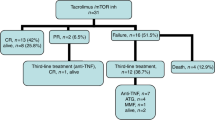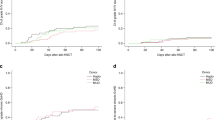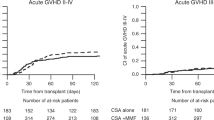Abstract
Antifungal prophylaxis with azoles is considered standard in allogeneic hematopoietic SCT (allo-HSCT). Although sirolimus is being used increasingly for the prevention of GVHD, it is a substrate of CYP3A4, which is inhibited by voriconazole, and concurrent administration can lead to significantly increased exposure to sirolimus. We identified 67 patients with hematologic malignancies who underwent allo-HSCT with sirolimus, tacrolimus and low-dose MTX and received concomitant voriconazole prophylaxis from April 2008 to June 2011. All patients underwent a non-myeloablative or reduced-intensity conditioned allo-HSCT. Patients received sirolimus and voriconazole concurrently for a median of 113 days. The median daily dose reduction of sirolimus at the start of coadministration was 90%. The median serum sirolimus trough levels before and at steady state of coadministration were 5.8 ng/mL (range: 0–47.6) and 6.1 ng/mL (range: 1–14.2) (P=0.45), respectively. One patient with an average sirolimus level of 6 ng/mL developed sirolimus-related thrombotic microangiopathy that resolved after sirolimus discontinuation. No sinusoidal obstructive syndrome was reported. Seventeen patients (25%) prematurely discontinued voriconazole because of the adverse events. Only two patients (3%) presented with possible invasive fungal infections at day 100. We demonstrate that sirolimus and voriconazole coadministration with an empiric 90% sirolimus dose reduction and close monitoring of sirolimus trough levels is safe and well tolerated.
This is a preview of subscription content, access via your institution
Access options
Subscribe to this journal
Receive 12 print issues and online access
$259.00 per year
only $21.58 per issue
Buy this article
- Purchase on Springer Link
- Instant access to full article PDF
Prices may be subject to local taxes which are calculated during checkout


Similar content being viewed by others
References
Mikulska M, Raiola AM, Bruno B, Furfaro E, Van Lint MT, Bregante S et al. Risk factors for invasive aspergillosis and related mortality in recipients of allogeneic SCT from alternative donors: an analysis of 306 patients. Bone Marrow Transplant 2009; 44: 361–370.
Neofytos D, Horn D, Anaissie E, Steinbach W, Olyaei A, Fishman J et al. Epidemiology and outcome of invasive fungal infection in adult hematopoietic stem cell transplant recipients: analysis of Multicenter Prospective Antifungal Therapy (PATH) Alliance registry. Clin Infect Dis 2009; 48: 265–273.
Lass-Florl C, Alastruey-Izquierdo A, Cuenca-Estrella M, Perkhofer S, Rodriguez-Tudela JL . In vitro activities of various antifungal drugs against Aspergillus terreus: global assessment using the methodology of the European committee on antimicrobial susceptibility testing. Antimicrob Agents Chemother 2009; 53: 794–795.
Ben-Ami R, Lewis RE, Kontoyiannis DP . Invasive mould infections in the setting of hematopoietic cell transplantation: current trends and new challenges. Curr Opin Infect Dis 2009; 22: 376–384.
Kontoyiannis DP, Marr KA, Park BJ, Alexander BD, Anaissie EJ, Walsh TJ et al. Prospective surveillance for invasive fungal infections in hematopoietic stem cell transplant recipients, 2001-2006: overview of the Transplant-Associated Infection Surveillance Network (TRANSNET) Database. Clin Infect Dis 2010; 50: 1091–1100.
Kurosawa M, Yonezumi M, Hashino S, Tanaka J, Nishio M, Kaneda M et al. Epidemiology and treatment outcome of invasive fungal infections in patients with hematological malignancies. Int J Hematol 2012; 96: 748–757.
Cecil JA, Wenzel RP . Voriconazole: a broad-spectrum triazole for the treatment of invasive fungal infections. Expert Rev Hematol 2009; 2: 237–254.
Perfect JR, Marr KA, Walsh TJ, Greenberg RN, DuPont B, de la Torre-Cisneros J et al. Voriconazole treatment for less-common, emerging, or refractory fungal infections. Clin Infect Dis 2003; 36: 1122–1131.
Troke P, Aguirrebengoa K, Arteaga C, Ellis D, Heath CH, Lutsar I et al. Treatment of scedosporiosis with voriconazole: clinical experience with 107 patients. Antimicrob Agents Chemother 2008; 52: 1743–1750.
Sehgal SN . Sirolimus: its discovery, biological properties, and mechanism of action. Transplant Proc 2003; 35: 7S–14S.
Alyea EP, Li S, Kim HT, Cutler C, Ho V, Soiffer RJ et al. Sirolimus, tacrolimus, and low-dose methotrexate as graft-versus-host disease prophylaxis in related and unrelated donor reduced-intensity conditioning allogeneic peripheral blood stem cell transplantation. Biol Blood Marrow Transplant 2008; 14: 920–926.
Ho VT, Aldridge J, Kim HT, Cutler C, Koreth J, Armand P et al. Comparison of Tacrolimus and Sirolimus (Tac/Sir) versus Tacrolimus, Sirolimus, and mini-methotrexate (Tac/Sir/MTX) as acute graft-versus-host disease prophylaxis after reduced-intensity conditioning allogeneic peripheral blood stem cell transplantation. Biol Blood Marrow Transplant 2009; 15: 844–850.
Perez-Simon JA, Martino R, Parody R, Cabrero M, Lopez-Corral L, Valcarcel D et al. The combination of sirolimus plus tacrolimus improves outcome after reduced-intensity conditioning, unrelated donor hematopoietic stem cell transplantation compared with cyclosporine plus mycofenolate. Haematologica 2013; 98: 526–532.
Ceberio I, Devlin SM, Sauter C, Barker JN, Castro-Malaspina H, Giralt S et al. Sirolimus, tacrolimus and low-dose methotrexate based graft-versus-host disease prophylaxis after non-ablative or reduced intensity conditioning in related and unrelated donor allogeneic hematopoietic cell transplant. Leuk Lymphoma (e-pub ahead of print 6 August 2014).
Bruggemann RJ, Alffenaar JW, Blijlevens NM, Billaud EM, Kosterink JG, Verweij PE et al. Clinical relevance of the pharmacokinetic interactions of azole antifungal drugs with other coadministered agents. Clin Infect Dis 2009; 48: 1441–1458.
Saad AH, DePestel DD, Carver PL . Factors influencing the magnitude and clinical significance of drug interactions between azole antifungals and select immunosuppressants. Pharmacotherapy 2006; 26: 1730–1744.
Dresser GK, Spence JD, Bailey DG . Pharmacokinetic-pharmacodynamic consequences and clinical relevance of cytochrome P450 3A4 inhibition. Clin Pharmacokinet 2000; 38: 41–57.
Surowiec D, DePestel DD, Carver PL . Concurrent administration of sirolimus and voriconazole: a pilot study assessing safety and approaches to appropriate management. Pharmacotherapy 2008; 28: 719–729.
Marty FM, Lowry CM, Cutler CS, Campbell BJ, Fiumara K, Baden LR et al. Voriconazole and sirolimus coadministration after allogeneic hematopoietic stem cell transplantation. Biol Blood Marrow Transplant 2006; 12: 552–559.
Bacigalupo A, Ballen K, Rizzo D, Giralt S, Lazarus H, Ho V et al. Defining the intensity of conditioning regimens: working definitions. Biol Blood Marrow Transplant 2009; 15: 1628–1633.
Ho VT, Cutler C, Carter S, Martin P, Adams R, Horowitz M et al. Blood and marrow transplant clinical trials network toxicity committee consensus summary: thrombotic microangiopathy after hematopoietic stem cell transplantation. Biol Blood Marrow Transplant 2005; 11: 571–575.
Rowlings PA, Przepiorka D, Klein JP, Gale RP, Passweg JR, Henslee-Downey PJ et al. IBMTR Severity Index for grading acute graft-versus-host disease: retrospective comparison with Glucksberg grade. Br J Haematol 1997; 97: 855–864.
Cornely OA, Bohme A, Reichert D, Reuter S, Maschmeyer G, Maertens J et al. Risk factors for breakthrough invasive fungal infection during secondary prophylaxis. J Antimicrob Chemother 2008; 61: 939–946.
De Pauw B, Walsh TJ, Donnelly JP, Stevens DA, Edwards JE, Calandra T et al. Revised definitions of invasive fungal disease from the European Organization for Research and Treatment of Cancer/Invasive Fungal Infections Cooperative Group and the National Institute of Allergy and Infectious Diseases Mycoses Study Group (EORTC/MSG) Consensus Group. Clin Infect Dis 2008; 46: 1813–1821.
Sadaba B, Campanero MA, Quetglas EG, Azanza JR . Clinical relevance of sirolimus drug interactions in transplant patients. Transplant Proc 2004; 36: 3226–3228.
Mathis AS, Shah NK, Friedman GS . Combined use of sirolimus and voriconazole in renal transplantation: a report of two cases. Transplant Proc 2004; 36: 2708–2709.
Kuypers DR, Claes K, Evenepoel P, Maes B, Vandecasteele S, Vanrenterghem Y et al. Drug interaction between itraconazole and sirolimus in a primary renal allograft recipient. Transplantation 2005; 79: 737.
Pai MP, Allen S . Voriconazole inhibition of tacrolimus metabolism. Clin Infect Dis 2003; 36: 1089–1091.
Mori T, Kato J, Yamane A, Sakurai M, Kohashi S, Kikuchi T et al. Drug interaction between voriconazole and tacrolimus and its association with the bioavailability of oral voriconazole in recipients of allogeneic hematopoietic stem cell transplantation. Int J Hematol 2012; 95: 564–569.
Trifilio SM, Scheetz MH, Pi J, Mehta J . Tacrolimus use in adult allogeneic stem cell transplant recipients receiving voriconazole: preemptive dose modification and therapeutic drug monitoring. Bone Marrow Transplant 2010; 45: 1352–1356.
Wang JL, Chang CH, Young-Xu Y, Chan KA . Systematic review and meta-analysis of the tolerability and hepatotoxicity of antifungals in empirical and definitive therapy for invasive fungal infection. Antimicrob Agents Chemother 2010; 54: 2409–2419.
Amigues I, Cohen N, Chung D, Seo SK, Plescia C, Jakubowski A et al. Hepatic safety of voriconazole after allogeneic hematopoietic stem cell transplantation. Biol Blood Marrow Transplant 2010; 16: 46–52.
Andes D, Pascual A, Marchetti O . Antifungal therapeutic drug monitoring: established and emerging indications. Antimicrob Agents Chemother 2009; 53: 24–34.
Scholz I, Oberwittler H, Riedel KD, Burhenne J, Weiss J, Haefeli WE et al. Pharmacokinetics, metabolism and bioavailability of the triazole antifungal agent voriconazole in relation to CYP2C19 genotype. Br J Clin Pharmacol 2009; 68: 906–915.
Dolton MJ, Ray JE, Chen SC, Ng K, Pont LG, McLachlan AJ . Multicenter study of voriconazole pharmacokinetics and therapeutic drug monitoring. Antimicrob Agents Chemother 2012; 56: 4793–4799.
Pascual A, Calandra T, Bolay S, Buclin T, Bille J, Marchetti O . Voriconazole therapeutic drug monitoring in patients with invasive mycoses improves efficacy and safety outcomes. Clin Infect Dis 2008; 46: 201–211.
Acknowledgements
We gratefully acknowledge the expert care provided to our patients by the fellows, physician assistants, nurse practitioners and nurses of Memorial Sloan Kettering Cancer Center.
Author information
Authors and Affiliations
Corresponding authors
Ethics declarations
Competing interests
IC received research support from Pfizer Spain. M-AP has served on advisory boards for Astellas and Merck. The remaining authors declare no conflict of interest.
Rights and permissions
About this article
Cite this article
Ceberio, I., Dai, K., Devlin, S. et al. Safety of voriconazole and sirolimus coadministration after allogeneic hematopoietic SCT. Bone Marrow Transplant 50, 438–443 (2015). https://doi.org/10.1038/bmt.2014.286
Received:
Revised:
Accepted:
Published:
Issue Date:
DOI: https://doi.org/10.1038/bmt.2014.286
This article is cited by
-
Interpretation and Understanding of Clinical Drug Interactions Between Azoles and Immunosuppressants in Solid Organ Transplant Recipients
Current Fungal Infection Reports (2020)



